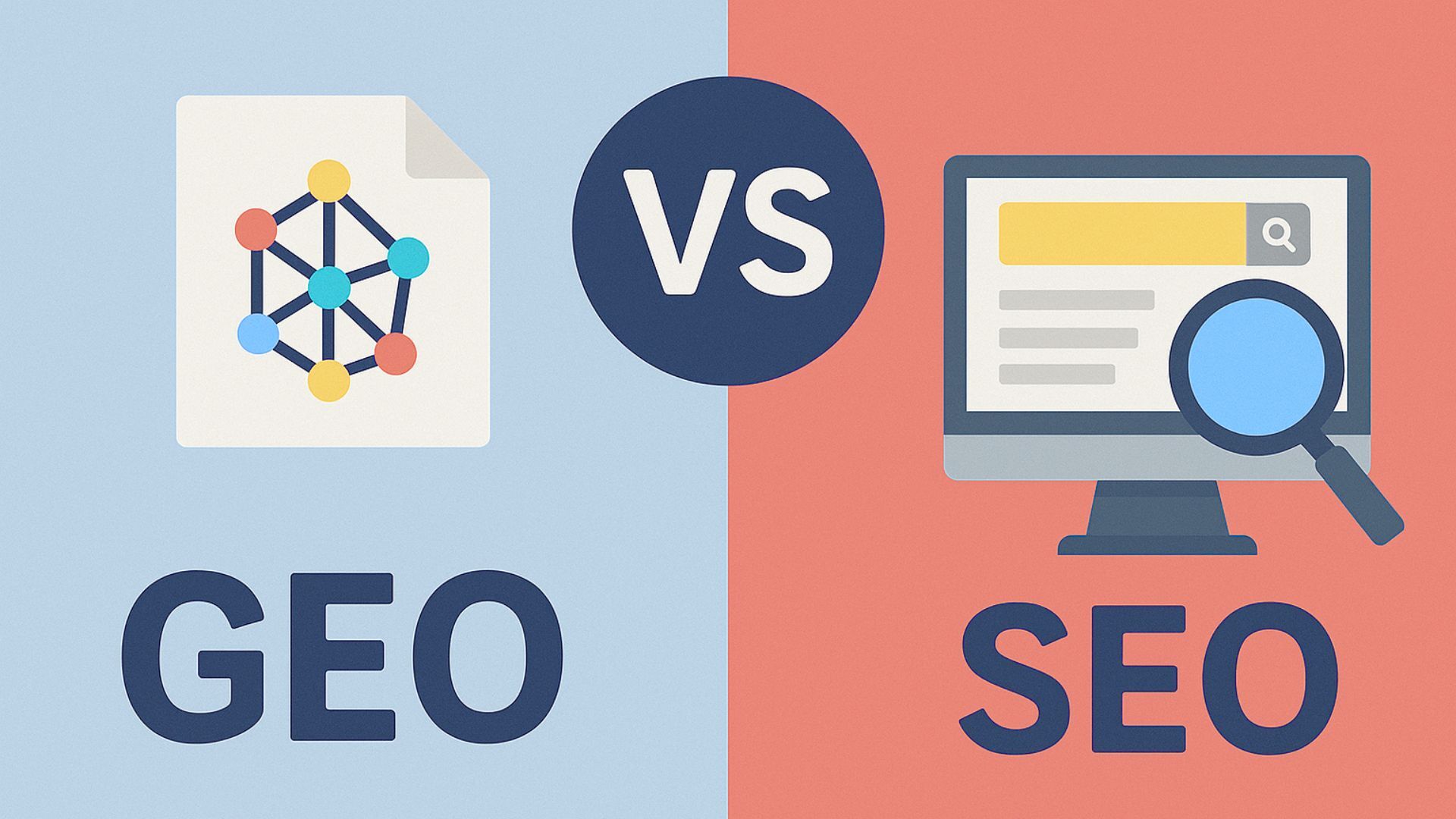GEO vs SEO: What’s The Difference?

As generative AI becomes central to how users retrieve and consume information online, digital marketers must adapt to a new search paradigm. Traditional search engines like Google and Bing are no longer the only gateways to visibility. The rise of generative AI engines such as Google’s Search Generative Experience (SGE) has introduced Generative Engine Optimization (GEO) as a crucial counterpart to traditional Search Engine Optimization (SEO). Understanding the difference between SEO and GEO is essential for staying competitive in both traditional and AI-driven search environments.
What Is Search Engine Optimization (SEO)?
Search Engine Optimization (SEO) is a digital marketing practice designed to enhance a website’s visibility on search engine results pages (SERPs). SEO focuses on enhancing the content, structure, and authority of a website to align with the search engine algorithms used by traditional search engines, such as Google and Bing. It relies heavily on keyword optimization, backlink building, technical SEO, and user experience improvements to increase search engine rankings.
SEO strategies are grounded in how search engines crawl, index, and rank web content. This includes optimizing metadata, URLs, internal linking, and site speed. Traditional SEO methods aim to enhance search engine rankings for specific queries, making SEO a vital strategy for generating organic traffic.
What Is Generative Engine Optimization (GEO)?
Generative Engine Optimization (GEO) is an emerging approach to optimizing content for generative AI-powered search engines and answer engines. Unlike traditional SEO, GEO focuses on how AI engines extract, interpret, and cite information in AI overviews. Generative search platforms, such as Google’s SGE and Bing Chat, are designed to generate summaries or direct answers based on vast content repositories, rather than just ranking pages.
GEO prioritizes content clarity, structured formatting, and source authority to ensure that content can be utilized effectively by AI tools. Implementing GEO involves techniques like citation optimization, entity recognition, and content structuring that align with how generative AI models parse and reproduce information.
Key Differences Between SEO and GEO
SEO and GEO serve different yet increasingly complementary functions in digital marketing. SEO relies on traditional search engine algorithms to determine content ranking based on relevance, authority, and user engagement. GEO focuses on optimizing for AI-driven search engines that generate answers directly from content, requiring a new emphasis on structured, citation-ready information.
Below is a comparison table summarizing the key differences:
| Aspect | SEO (Search Engine Optimization) | GEO (Generative Engine Optimization) |
| Definition | Optimizes for visibility in traditional search engines through content, links, and keywords | Optimizes for AI-generated answers by making content accessible to generative AI models |
| Target | Traditional search engines like Google and Bing | AI-powered search engines and generative engines such as Google’s SGE and Bing Chat |
| Metrics | Click-through rates, bounce rates, dwell time, and rankings on SERPs | AI citations, content impressions in AI overviews, and inclusion in generative responses |
| Strategies | Keyword optimization, link building, technical SEO, and UX improvements | Citation optimization, content clarity, structured data, and entity recognition |
| Content Focus | Query-matching, readability, engagement, and authority | Extractable, factual, and source-attributable content suitable for AI engines |
| Search Context | Works within traditional search engine results pages | Targets AI-generated overviews and answer engines outside traditional search structures |
These differences mark a significant evolution in how digital content should be crafted for search visibility.

Similarities Between SEO and GEO
Despite their different targets, SEO and GEO share core principles. Both prioritize high-quality, relevant content designed to meet user intent. Each strategy values authority, structured information, and a clear understanding of audience needs. While their execution diverges, SEO and GEO both aim to improve visibility on search engines, whether in traditional search results or AI-generated answers.
How SEO Works: The Traditional Approach
SEO strategies revolve around making content discoverable and valuable to traditional search engine algorithms. This involves keyword research, on-page SEO practices such as heading optimization and internal linking, and off-page strategies, including acquiring backlinks. Technical SEO ensures search engine bots can crawl and index site content efficiently. Technical SEO also includes optimizing for performance metrics, such as Core Web Vitals, which assess loading speed, interactivity, and visual stability, factors that directly impact both user experience and search engine rankings.
SEO remains effective because it aligns with search engine algorithms to drive long-term traffic. Traditional SEO practices also support improvements in user experience, which further enhance performance on search engine results pages.
How GEO Works: The New AI-Driven Approach
GEO operates within the framework of generative search, where content is not merely ranked but referenced, cited, or summarized by AI models. This requires content to be structured in a way that AI engines can easily extract and repurpose. Clear headings, factual accuracy, and transparent citations become critical.
Unlike traditional search, generative search engines do not rely solely on links and clicks. GEO ensures your content is recognized by AI engines like ChatGPT and Google’s SGE by enhancing its machine-readability and credibility. GEO strategies also focus on optimizing for AI models like those powering generative search engines.
Why SEO Still Matters
SEO remains crucial for traditional search engine optimization and remains a foundational pillar of digital marketing. It provides long-term visibility in search engines, drives sustainable traffic, and delivers a measurable ROI. Traditional SEO methods are well-established and continue to evolve in response to algorithm changes.
SEO also complements GEO by establishing the authority and clarity that generative AI models look for. SEO best practices remain essential for digital marketers seeking to enhance search engine performance and maintain a competitive edge.
Benefits of Implementing GEO
Adopting GEO offers access to new visibility layers in AI-driven environments. As AI-powered search engines and generative AI models continue to grow in usage, GEO offers a way to stay ahead. It increases the likelihood of content being included in AI-generated overviews and answer engines.
GEO personalizes user experiences by allowing AI engines to deliver precise, cited answers. It enhances traditional SEO by expanding its reach into generative search platforms. GEO is becoming important not just as a supplement, but as a strategic necessity in AI search.
How to Integrate SEO and GEO Strategies
Content for both GEO and SEO can be developed in tandem. Utilize keyword optimization and technical SEO to cater to traditional search algorithms, while also structuring content for AI models. GEO strategies such as citation optimization and entity clarity can be layered onto SEO efforts without replacing them.
Optimizing for AI does not mean abandoning SEO. Instead, integrating both ensures full-spectrum visibility on search engines like Google and Bing, across both traditional and generative formats. The future of SEO lies in embracing the evolution of AI-driven search engines and implementing GEO where it matters.
Conclusion
The difference between SEO and GEO is not one of replacement, but rather expansion. SEO focuses on ranking in traditional search engine results, while SEO focuses on visibility in AI-generated responses. By combining both strategies, marketers can enhance their reach across all search formats. As search engines evolve, so too must the strategies we use to maintain visibility and authority in the digital space.


